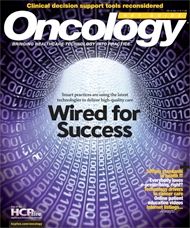Publication
Article
ONCNG Oncology
Eye on Innovation: 23andMe
Linda Avey, co-founder of 23andMe explains how the company processes customers’ small saliva samples and extracts data using a custom DNA chip.
Linda Avey, co-founder of 23andMe—a Web-based service that aims to be “the world’s trusted source for personal genetic information”—explains how the company processes customers’ small saliva samples and extracts data using a custom DNA chip, which is then presented on a secure website using interactive tools that offer information about ancestry, inherited traits, and disease risk.
Who is using the website?
We’ve found that 23andMe.com’s customer base is incredibly diverse. It includes early adopters—people on the cutting edge of technology. Others are adoptees, who know little, if anything, about their background and want to discover their ancestry and see what information they can fill in about their potential health risks that they do not know about through family history. Others are at a point in their lives where they’re interested in creating a family legacy—those who want to have their whole families genotyped to ensure that a genetic history is left for future generations. Some are genealogists, who are interested in tracing their genetic roots.
How is risk determined from the sample?
After a customer sends in his or her saliva sample to our Clinical Laboratory Improvement Amendments-certified lab, DNA is extracted from the saliva, and more than a half-million single nucleotide polymorphisms (SNPs) are analyzed and converted into digital data. These data are then loaded into our secure, encrypted system, and a 23andMe genetic profile is created for that individual on our website. His or her genotype data are automatically plugged into the risk-determining algorithms, and the service then presents these reports to that individual through the private, personal account. The custom array is just a portion of the DNA chip; this custom portion was designed by our scientists to include genetic markers that can provide our customers with more relevant data on published associations, as well as maternal and paternal ancestry. The DNA chip is extremely accurate at measuring genotypes. The accuracy in assessing disease risk depends on how much research has been done on the genetics of any particular disease; there will be more confidence about an association if the finding has been replicated in more than one study and if those studies included large numbers of test subjects. We classify the genetic understanding of diseases or traits into two categories: clinical reports (which include associations that have been replicated in large, independent studies) and research reports (smaller sample sizes and, perhaps, no replication). Another factor that contributes to the accuracy of assessing disease risk is the eff ect of the particular SNPs. For instance, one version of a SNP associated with venous thromboembolism evidently increases one’s risk about ten-fold compared to the other. Other SNPs with smaller eff ects are less predictive of whether or not one will get the disease. Our scientists are always reviewing the latest published research studies to determine which associations to include in our clinical report section (where we calculate genetic risk) and then calculating the risk for people with each possible genotype that the SNPs identified in the studies. They make this calculation based on the odds ratio for each genotype read (or “call”), the incidence of the disease, and the frequency of the genotypes in the population that was studied. Once this is calculated, our science writers generate a report, discussing the disease or trait and the genetics behind it. New reports are generated for our customers on an on-going basis. You can find a full list of the traits and conditions we report on at www.23andme.com/health/all.
Who can most benefit from the site’s breast cancer initiative software?
There are two components to our initiative, one being an online community of individuals who can connect with each other and ask questions, share experiences, and engage in discussions about breast cancer. Many groups can benefit from the community component, including survivors, family members, and those who may be at greater risk for breast cancer. The other component is a future research study, in which we plan to study the genetics behind the disease and the various treatments. For the study, we would examine a large group of women who have had breast cancer and those who have not. The group that seemingly would benefit the most from new discoveries about the genetics of breast cancer would be those at genetic risk for the disease.
